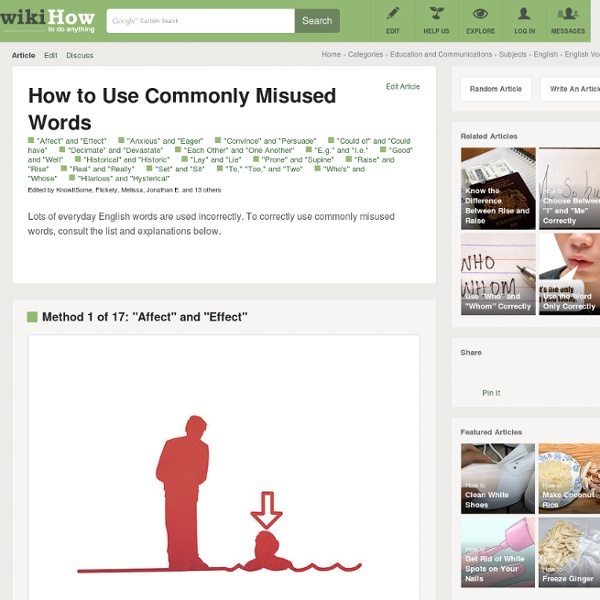Themes & Things To Keep In Mind When Writing Fantasy Stories and Adventures » Daily Encounter
This list is far from complete. It’s not even trying to be complete. It knows better than that. It just wants to be helpful and provide some inspiration here and there; you know, offer little suggestions that might lead to bigger ideas.
What can Diane Arbus teach you about writing?
I always thought of photography as a naughty thing to do - that was one of my favorite things about it, and when I first did it, I felt very perverse. -- Diane Arbus Diane Arbus (1923-1971) was an American photographer and a student of human diversity, often described as a "photographer of freaks." Maybe one should admit that freakishness comes from within and 'normal' is a mirage. Join me now, fellow freak, and let us contemplate the normalness of strangehood.*
List of idioms in the English language
This is a list of notable idioms in the English language. An idiom is a common word or phrase with a culturally understood meaning that differs from what its composite words' denotations would suggest. For example, an English speaker would understand the phrase "kick the bucket" to mean "to die" – and also to actually kick a bucket. Furthermore, they would understand when each meaning is being used in context. An idiom is not to be confused with other figures of speech such as a metaphor, which invokes an image by use of implicit comparisons (e.g., "the man of steel" ); a simile, which invokes an image by use of explicit comparisons (e.g., "faster than a speeding bullet"); and hyperbole, which exaggerates an image beyond truthfulness (e.g., like "missed by a mile" ). Idioms are also not to be confused with proverbs, which are simple sayings that express a truth based on common sense or practical experience.
Self publishing costs nothing
A number of people have asked me “How much does self-publishing cost?”, so this post will clear that up. It may be controversial! Please do post comments if you disagree or have questions.
This Itch of Writing: But can you teach Creative Writing?
I get asked this amazingly often, considering that no one ever asks if you can teach the doing of other arts, but, just as I took ages to get on to that other old chestnut, "What is literary fiction?" and my own personal Ancestral Elephant, it's taken me till now to sort out what I think clearly enough to answer the question. My answer, mind you, depends on how long I've got, but it comes from someone who wrote for fifteen years before being taught, (and my thoughts on the pros and cons of writing courses are here) but now teaches, and knows hundreds of writers who have been taught, and hundreds who haven't been taught, and not a few who teach:
Writing Meaningful Description
To the reader? The world of your book is a black box. Devoid of all sensation—no sights, sounds, tastes, smells, or aural pleasantries beyond dialogue. It is up to you and your prowess of description to fill that world out—to let the reader experience it as you would have it experienced.
Typographer's Glossary
Serif: Serif's are semi-structural details on the ends of some of the strokes that make up letters and symbols. A typeface that has serifs is called a serif typeface (or seriffed typeface). Some of the main classifications of Serif type are: Blackletter, Venetian, Garalde, Modern, Slab Serif, Transitional, and Informal. Fonts in each classfication share certain similiar characteristics including the shape or appearance of their serifs. Serif fonts are widely used in traditional printed material such as books and newspapers. Show all Serif Didone is a typeface classification characterized by slab-like serifs without brackets; vertical orientation of weight axes.
Why “Show, Don’t Tell” Is the Great Lie of Writing Workshops
I’m honored and excited today to be bringing you a guest post by critically acclaimed novelist and writing instructor Joshua Henkin. I first discovered Henkin’s work years ago when I received an advance copy of his novel Matrimony at Book Expo America, and I later enjoyed having him contribute a thought-provoking essay on the art of storytelling to Writer’s Digest magazine (in fact, two of his writing tips from that piece made our Top 20 Writing Lessons From WD list in 2009). I invited Joshua Henkin to be our guest this week in celebration of the release of his brand-new novel, The World Without You. His topic of choice—a sound argument for breaking the “Show Don’t Tell” rule of writing—is a perfect extension of my post last week about How to Break the Rules of Writing. Joshua Henkin is the author of the novels Matrimony, a New York Times Notable Book, and Swimming Across the Hudson, a Los Angeles Times Notable Book. Why “Show, Don’t Tell” Is the Great Lie of Writing Workshops
Feelings Character Table
Character Feelings You can describe your character's feelings in more exact terms than just "happy" or "sad." Check these lists for the exact nuance to describe your character's intensity of feelings. SF Characters | SF Items | SF Descriptors | SF Places | SF EventsSF Jobs/Occupations | Random Emotions | Emotions List | Intensity of Feelings
Heroes of History - The Heroic Monomyth
As of July 1, 2013 ThinkQuest has been discontinued. We would like to thank everyone for being a part of the ThinkQuest global community: Students - For your limitless creativity and innovation, which inspires us all. Teachers - For your passion in guiding students on their quest.
HOW TO WRITE GOOD
Caveat emptor. Carpe diem. O si villi, si ergo, fortibus es in ero. Et tu, brute.



